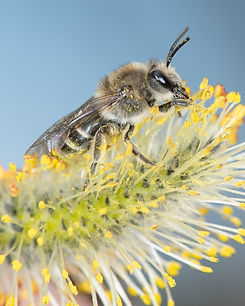
Family Apidae > Genus Ceratina
Ceratina
Small Carpenter Bees
In Minnesota, there are four described species within the genus Ceratina. These relatively hairless, tiny metallic-blue bees are 2 to 9 mm in length (0.08 to 0.35") and are on the wing from early spring to late autumn. All four species nest in pithy perennial or woody plant stems and have eusocial nests. Each female initiates a nest by herself in a plant stem or pithy wood branch. The female remains alive while the larvae develop in the nest, pupate, then become adults. For some species, the offspring emerge as adults the same growing season, may help rear more offspring, then overwinter in other stems than their nest. The female interacts with her offspring and provides some limited parental care. Prior to offspring emergence the following growing season, the female guards the nest, perching at the end of the cavity over the winter. Mating occurs in spring.
Like other bees in the family Apidae, Ceratina have a very long glossa (tongue) that allows them to access nectaries from tubular or more complexly-shaped flowers. Ceratina are commonly found in yards and gardens and are polylectic, visiting a wide variety of flowers belonging to many plant families and genera.

A Ceratina female visiting Coreopsis lanceolata.

A Ceratina nest in a perennial plant stem.

A Ceratina female visiting Erigeron (fleabane).

A Ceratina female excavates a nest in a Rhus (sumac) stem.


Wing
position
on flowers
4
no. species
in MN
size range

Phenology

Genus Characteristics

Long glossa (tongue).
male

female
Female lacking a pygidial plate; abdomen terminates in a point.

female
Female with small white marking on clypeus (sometimes absent).

male
Male with inverted T-shaped white marking on clypeus.

female
Scopal hairs on hind leg tibiae (females).

female
Metallic-blue, relatively hairless, hourglass-shaped body, with lobed abdominal tergites.
Distribution

Ceratina calcarata

Ceratina dupla

Ceratina mikmaqi

Ceratina strenua
Ceratina Species in Minnesota
Scientific Name | Nest | Sociality / Voltinism | Abundance |
|---|---|---|---|
Ceratina calcarata | plant stems, pithy wood branches | eusocial, univoltine | common |
Ceratina dupla | plant stems, pithy wood branches | eusocial, univoltine/bivoltine | common - uncommon |
Ceratina mikmaqi | plant stems, pithy wood branches | eusocial, univoltine | abundant |
Ceratina strenua | plant stems, pithy wood branches | eusocial | rare |
Explore More Apidae Genera
Explore Bee Families

Apidae
15 genera, 133 species
Bumble bees Bombus
Longhorn bees
Epimelissodes, Eucera, Melissodes
Carpenter bees
Ceratina, Xylocopa
Honey bees Apis
Digger bees Anthophora
Cuckoo bees Brachymelecta, Epeolus, Holcopasites, Nomada, Neolarra, Triepeolus
Squash bees Xenoglossa

2 genera, 39 species
Halictidae
10 genera, 133 species
Metallic green sweat bees
Agapostemon, Augochlora, Augochlorella, Augochloropsis
Large sweat bees
Dieunomia, Nomia
Short-faced bees Dufourea
Sweat bees Halictus
Small sweat bees Lasioglossum
Cuckoo (blood) bees Sphecodes
Megachilidae
14 genera, 86 species
Resin and pebble bees Anthidiellum, Dianthidium, Heriades, Paranthidium
Carder bees Anthidium, Pseudoanthidium
Mock orange bees Chelostoma
Mason bees Osmia, Hoplitis
Leafcutter bees Megachile
Sharp-tailed cuckoo bees Coelioxys
Dark cuckoo bees Stelis

Citations and Further Reading
Droege, S., Shumar, S., & Maffei, C. (2024). The Very Handy Bee Manual (2.0). Zenodo. https://doi.org/10.5281/zenodo.12812755
Mitchell, T. B. (1960). Bees of the eastern United States. Technical Bulletin No. 141. North Carolina Agricultural Experiment Station.
Portman, Z. M., Gardner, J., Lane, I. G., Gerjets, N., Petersen, J. D., Ascher, J. S., ... & Cariveau, D. P. (2023). A checklist of the bees (Hymenoptera: Apoidea) of Minnesota. Zootaxa, 5304(1), 1-95.
Vickruck, J. L., Rehan, S. M., Sheffield, C. S., & Richards, M. H. (2011). Nesting biology and DNA barcode analysis of Ceratina dupla and C. mikmaqi, and comparisons with C. calcarata (Hymenoptera: Apidae: Xylocopinae). The Canadian Entomologist, 143(3), 254-262.
Wilson, J. S., & Messinger Carril, O. J. (2016). The bees in your backyard: a guide to North America's bees. Princeton University Press.


















